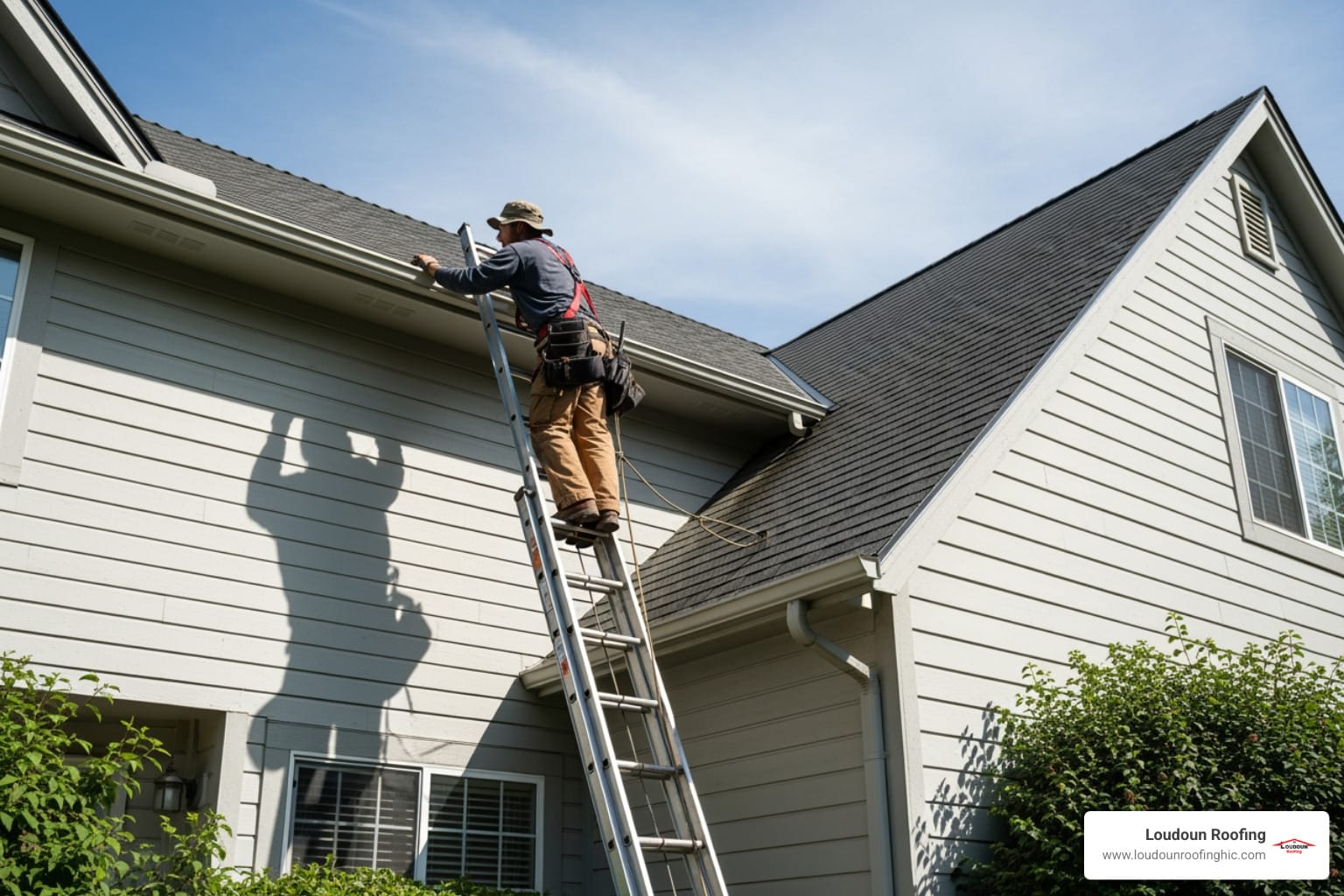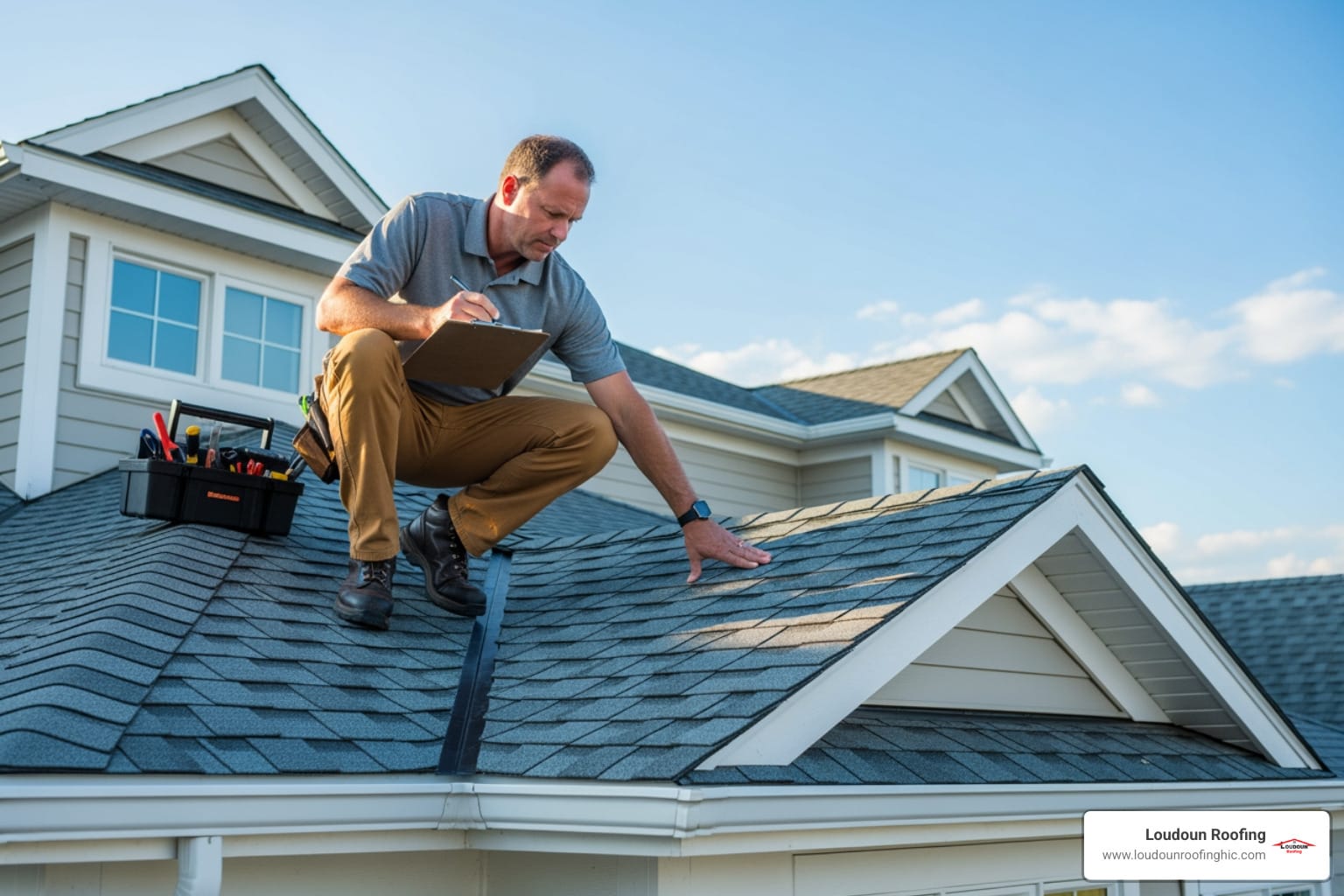Why Professional Roof and Chimney Repair Services Matter
Roof and chimney repair is essential for protecting your home from water damage, structural issues, and safety hazards. When these critical components fail, the consequences can be costly and dangerous. For Northern Virginia homeowners, finding a trusted local roofing contractor who understands both roofing and masonry is crucial for getting the job done right.
Quick Answer for Roof and Chimney Repair:
- Minor repairs: $150-$500 (small cracks, chimney cap replacement)
- Major repairs: $500-$5,000+ (flashing, flue liner, extensive masonry work)
- Full rebuild: $5,000-$13,300+ (severe structural damage)
- Call a roofer for: Flashing issues, roof leaks, shingle damage
- Call a mason for: Brick repair, mortar joints, chimney crown problems
Your chimney and roof work as a team, but the area where they meet is where most problems start. Water can sneak through damaged flashing, cracked mortar, or missing shingles. A damaged chimney can leak carbon monoxide into your home or cause a house fire, while roof leaks can rot your home’s structure from the inside out. That’s why industry data shows 80% of roofs inspected have chimneys that need attention.
At Loudoun Roofing & Home Improvement, we’ve been tackling complex roof and chimney repair projects since 2001, mastering everything from tricky flashing installations to challenging masonry work. Our hands-on approach ensures every project meets the highest standards for Northern Virginia homeowners.
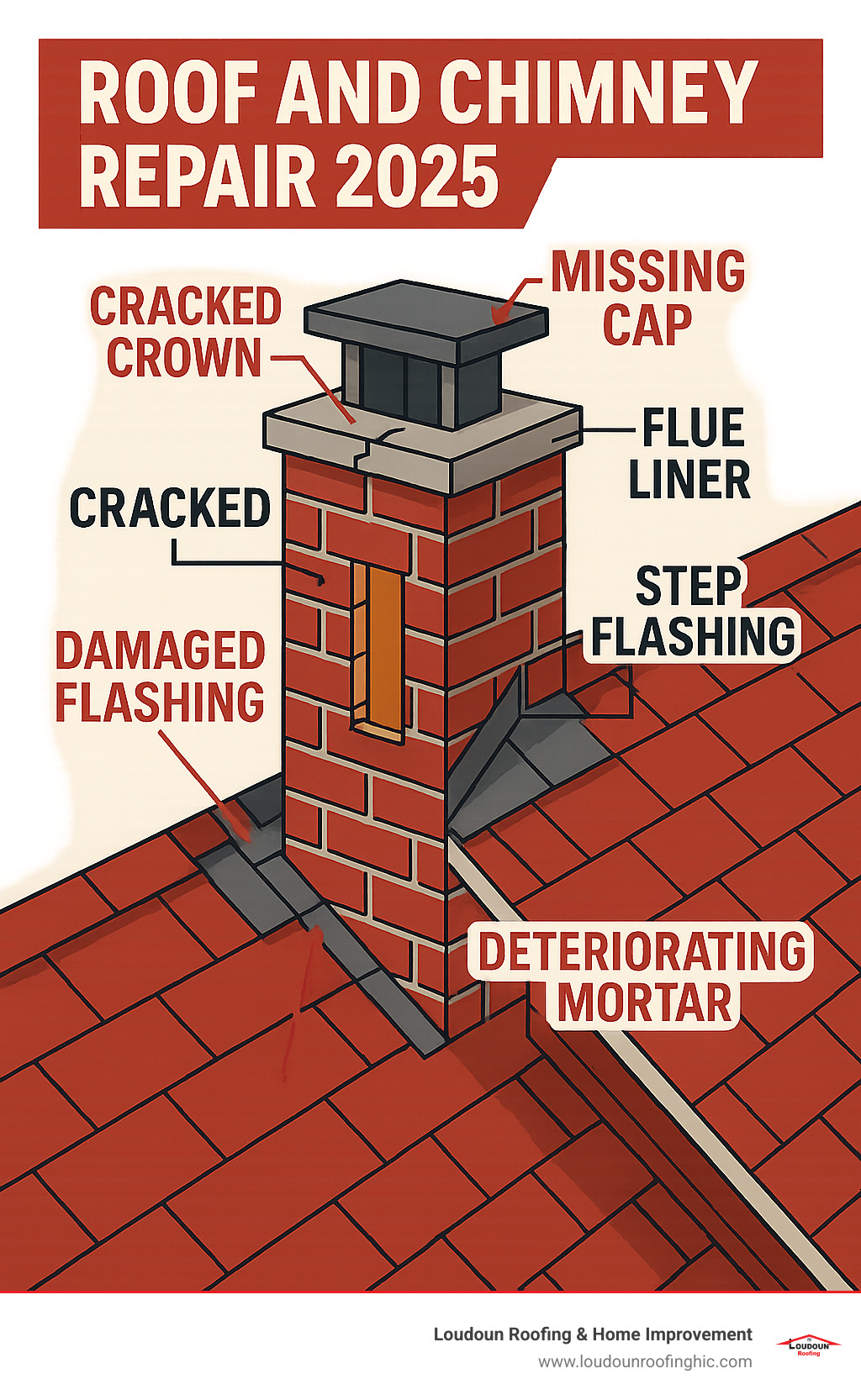
Identifying the Red Flags: Common Signs of Chimney and Roof Damage
Knowing what to look for can save you from costly repairs. Your chimney and roof are constantly exposed to the elements, making them prone to wear and tear. Here are the common signs that your chimney or roof needs attention.
Exterior Warning Signs
The exterior of your chimney is often the first place to show distress. Here’s what to look for:
- Cracked Chimney Crown: The concrete crown on top of your chimney protects it from water. Cracks allow water to seep into the structure, leading to expensive damage if not addressed.
- Spalling or Flaking Bricks: When moisture freezes inside bricks, it causes the face to crumble or flake off (spalling). This is a clear sign of water penetration that can compromise the chimney’s structural integrity.
- Deteriorating Mortar Joints: The mortar holding your bricks together is crucial. If it’s crumbling or eroded, water is getting into the masonry, often requiring repointing.
- White, Chalky Stains (Efflorescence): These white salt deposits are left behind after water evaporates from the masonry. It’s a tell-tale sign of excess moisture, often from a damaged cap or flashing.
- Rusted Firebox or Damper: Rust on the metal components inside your fireplace indicates excess moisture within the chimney, possibly from a damaged crown, cap, or flashing.
- Leaning or Tilting Chimney Stack: This is a serious structural issue indicating a compromised foundation or significant masonry deterioration. A leaning chimney requires immediate professional assessment.
Interior Warning Signs
Damage can also be visible from inside your home:
- Water Stains on Walls or Ceilings Near the Fireplace: Discoloration or dampness near the chimney is a major indicator of a leak, likely from damaged flashing, a cracked crown, or compromised masonry.
- Flakes of Tile or Masonry in the Hearth: Finding pieces of tile or ceramic in your fireplace means your flue liner is likely deteriorating. A damaged liner is a serious fire hazard.
- Unpleasant, Damp Odors from the Fireplace: A persistent musty smell, especially after rain, suggests moisture intrusion and potential mold growth within the chimney.
- Smoke Backing Up into the Room: If smoke fills your living space, it could be due to a blocked or damaged flue liner or other structural issues. This poses a serious carbon monoxide risk.
Roof-Related Issues Around the Chimney
The area where the chimney meets the roof is particularly vulnerable:
- Damaged, Loose, or Missing Shingles: Shingles around the chimney can wear out or be lifted by wind, creating pathways for water.
- Rusted, Cracked, or Separated Chimney Flashing: Flashing is the metal barrier sealing the chimney-to-roof connection. If it fails, water will easily get into your home. This is a very common cause of roof leaks.
- Soft or Rotting Wood on the Roof Deck Near the Chimney Base: Soft spots or visible rot in the roof deck or fascia mean water has been consistently penetrating the area.
- Clogged Gutters Causing Water to Overflow onto the Chimney: When gutters are clogged, overflowing water can cascade onto the chimney, accelerating masonry deterioration.
If you observe any of these signs, it’s crucial to act promptly. Delaying repairs can turn minor issues into major, costly problems.
Understanding Your Options: Common Types of Roof and Chimney Repair
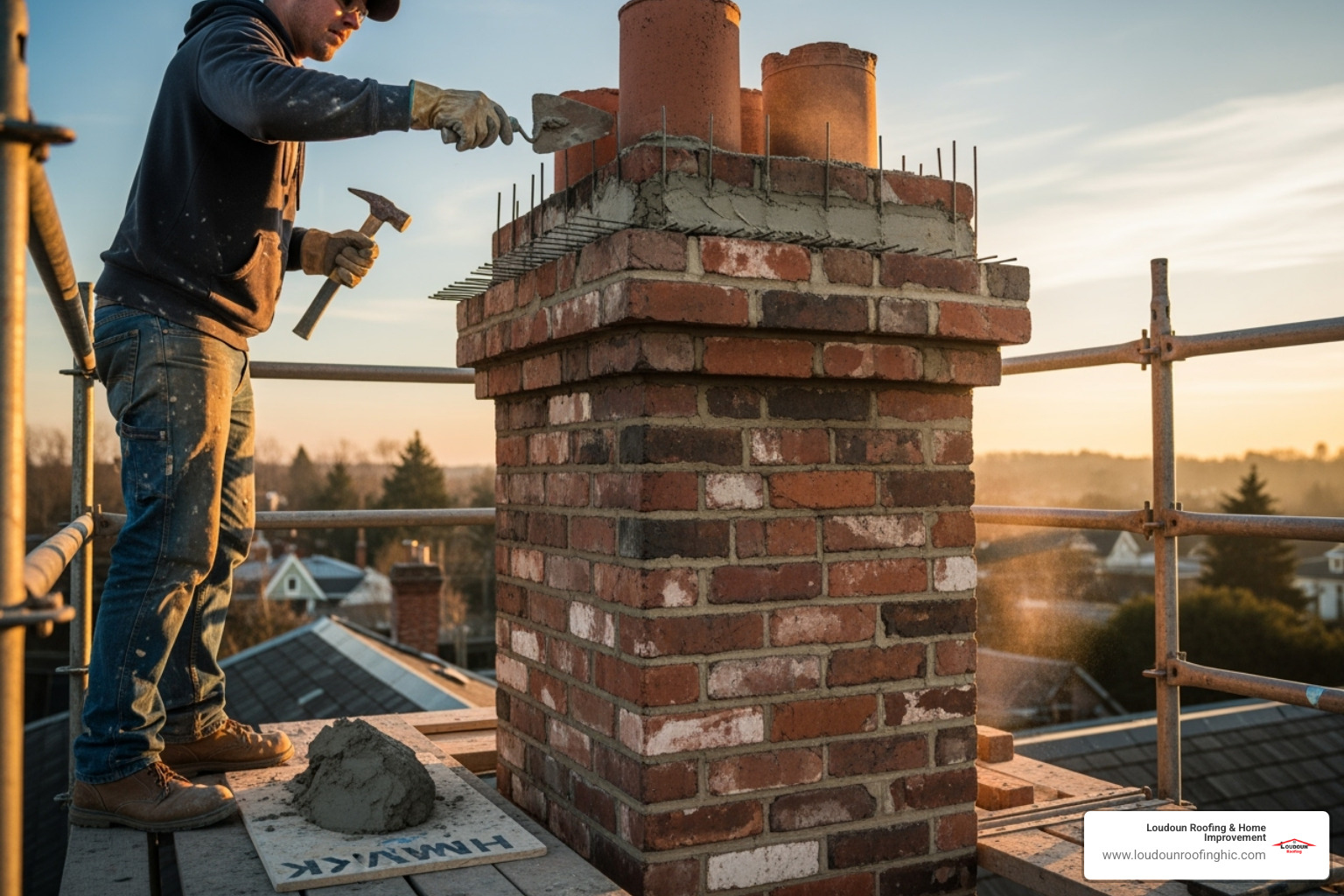
Once you’ve spotted a problem, it’s time to explore solutions. Most roof and chimney repair issues have a fix, from simple patches to complete overhauls. Here are the common options.
Masonry and Structural Repairs
Addressing masonry issues quickly prevents small problems from becoming big headaches.
Repointing and tuckpointing are solutions for deteriorating mortar joints. Repointing replaces old, crumbling mortar with fresh material. Tuckpointing is a more refined finish. Costs typically range from $500 to $2,500.
Brick replacement involves carefully removing damaged bricks and installing matching new ones to maintain the chimney’s strength and appearance.
Your chimney crown is the concrete cap protecting the chimney from water. We can patch minor cracks and apply a waterproof sealant. If it’s badly deteriorated, a replacement, typically costing $500 to $1,500, is the best long-term solution.
For severe structural issues, partial or full rebuilds are necessary. A partial rebuild addresses specific problem areas, while a full rebuild starts fresh. Costs can range from $500 for minor work to over $13,300 for a complete rebuild.
The Critical Role of Chimney Flashing Repair
Most chimney leaks start with the flashing—the metal pieces sealing the gap where your chimney meets the roof.
Step flashing weaves into the shingle courses, while counter flashing is mortared into the chimney and covers the step flashing. Together, they form a shield that directs water away.
Flashing can fail due to rust, punctures, or improper installation. Visible rust, cracks, or water stains on your ceiling are clear warning signs.
The repair process involves removing the old material and installing new, durable flashing, often made of copper or stainless steel. We ensure it integrates perfectly with your roof and chimney to create a watertight seal. Most flashing repairs cost between $200 and $600, making it a cost-effective way to prevent major water damage. Our comprehensive roof repair services include all aspects of chimney flashing.
Internal and Protective Repairs
What’s inside your chimney is just as important for safety and performance.
Your flue liner contains heat and corrosive gases, protecting the chimney’s masonry. If you find tile flakes in your hearth, the liner may be damaged and needs immediate attention. We can patch cracks or install a new liner, with costs ranging from $1,000 to $5,000 or more.
Chimney cap installation is a simple fix that prevents many problems. For $100 to $500, a cap blocks rain, debris, and animals from entering your flue.
Finally, applying waterproof sealant to the chimney’s exterior creates an invisible barrier against moisture. This breathable coating allows masonry to dry out while preventing new water from soaking in.
The Financial Side: Breaking Down Chimney Repair Costs
Roof and chimney repair costs can vary widely, from a few hundred to several thousand dollars. Understanding the factors that influence the price can help you plan accordingly.
Factors Influencing the Price Tag
Several factors determine your final cost. The severity of damage is the biggest one. A hairline crack is an affordable fix, while a leaning chimney is a major project.
Your chimney’s height and your roof’s pitch also affect the cost. Taller chimneys and steeper roofs require more equipment, like scaffolding and specialized safety gear, which increases labor time and expense.
Materials matter too. Basic galvanized steel flashing is cheaper than long-lasting copper. Historic homes may require specialized mortar, which can increase costs. Labor and equipment needs are also major drivers; complex jobs requiring skilled masons cost more.
Typical Cost Ranges for Roof and Chimney Repair Services
Here’s a general breakdown of costs:
- Minor repairs ($150 – $500): Includes small crack sealing or installing a new chimney cap.
- Masonry repairs ($500 – $2,000+): Covers repointing mortar joints or replacing damaged bricks.
- Flashing replacement ($200 – $600): A critical repair for preventing water intrusion.
- Flue liner replacement ($1,000 – $5,000+): Essential for safety, this is not an area to cut corners.
- Chimney crown repair or replacement ($500 – $1,500).
- Full rebuild ($5,000 – $13,300+).
The average chimney repair is around $750, but the final cost depends entirely on the scope of work.
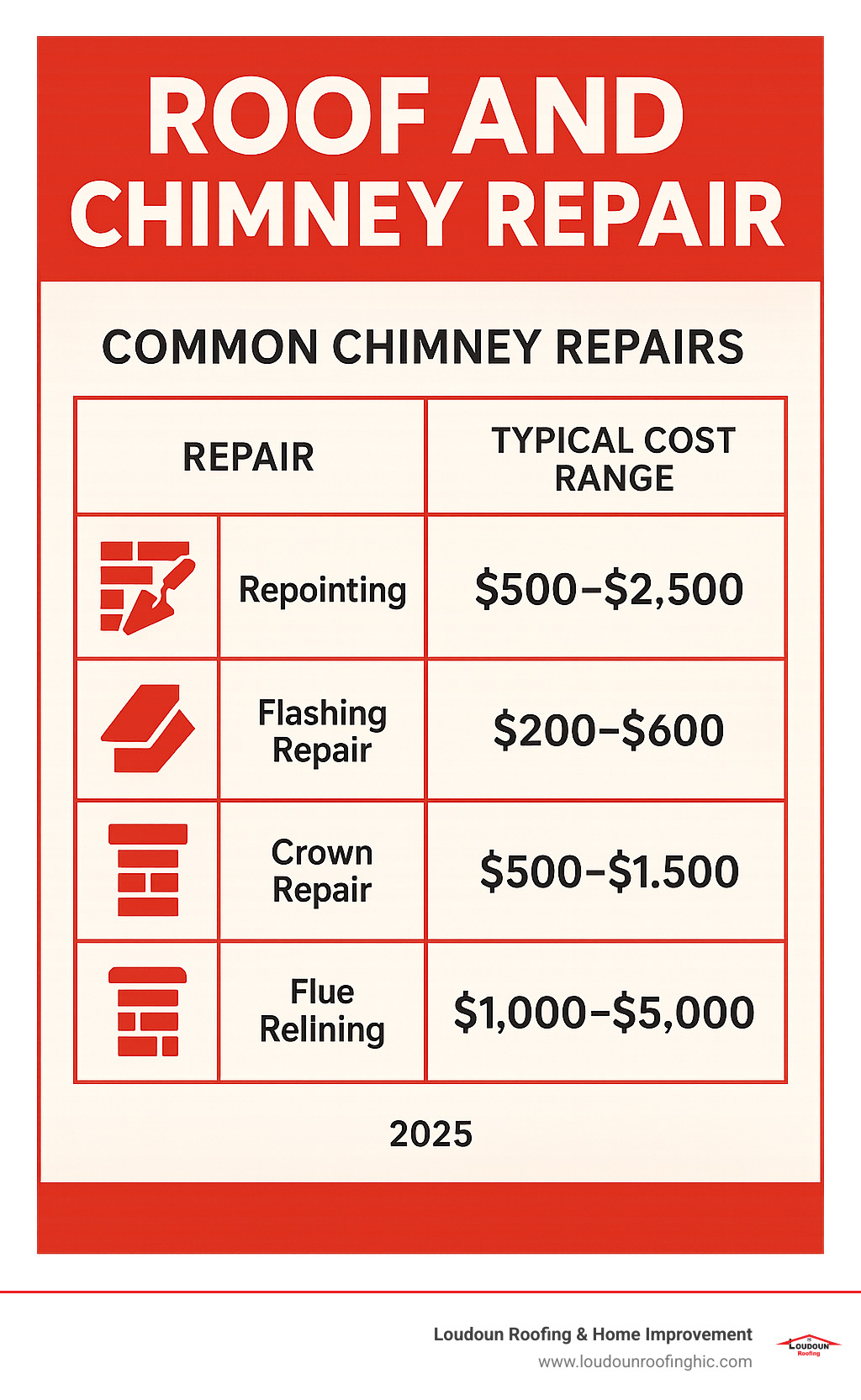
Repair vs. Replacement: Making the Cost-Effective Choice
Deciding whether to repair or replace is a key financial decision.
Minor issues are usually repair territory. A few spalled bricks, a cracked crown, or compromised flashing can often be fixed affordably. Catching these problems early saves money.
Replacement becomes the smarter choice when dealing with serious structural damage. If your chimney is leaning, has extensive crumbling masonry, or was damaged in a fire, rebuilding is often safer and more cost-effective long-term.
A good rule of thumb: if repair costs approach the cost of a rebuild, replacement usually offers better long-term value. You get a fresh start with modern materials and the peace of mind that comes with knowing everything is up to current safety standards. We can also help you determine if your roof insurance claims explained might cover some of these costs.
Hiring the Right Pro: Mason vs. Roofer and What to Look For
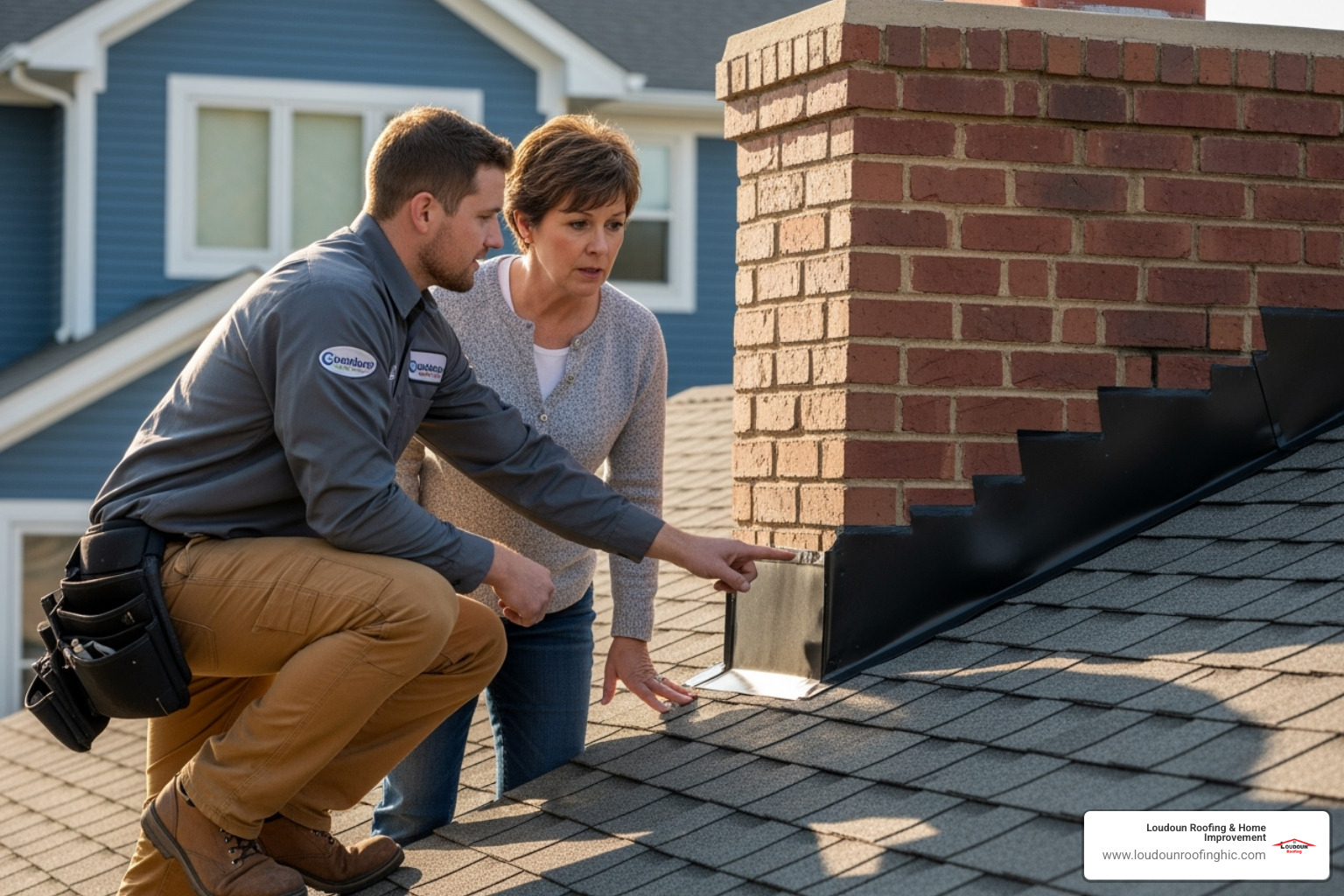
When your chimney has problems, it can be confusing to know whether to call a mason or a roofer. The right choice depends on the issue and can save you time and money.
Masonry Expert or Roofing Contractor?
Think of your chimney as two parts: the brick structure and its connection to the roof.
Call a mason for issues with the chimney’s structure. If you see crumbling bricks, deteriorating mortar, or cracks in the crown, a mason is the right professional. They specialize in brick, stone, and mortar work.
Call a roofer when the problem involves the chimney’s connection to the roof. Damaged flashing, roof leaks around the chimney, or missing shingles are all roofing issues. Roofers understand water flow and proper sealing techniques.
Often, the best solution is a full-service roofing company that handles both. At Loudoun Roofing & Home Improvement, we know that chimney problems are rarely isolated. A leak might involve both bad flashing and deteriorating mortar. Using one team that understands both aspects ensures better coordination and a more reliable repair.
Vetting Your Roof and Chimney Repair Professional
Finding the right contractor for your roof and chimney repair requires some due diligence.
- License and Insurance: Always verify your contractor is properly licensed and insured. This protects you from liability.
- Certifications: Look for credentials from organizations like the Chimney Safety Institute of America, which show a commitment to safety and education.
- Reviews and References: Read local reviews and ask for references. Past customers can provide honest feedback on a contractor’s professionalism and quality of work.
- Detailed Estimate: A professional provides a detailed, written estimate breaking down the work, materials, and costs. Be wary of vague estimates or high-pressure sales tactics.
- Warranties: Ask about warranties on both labor and materials. A reputable company will stand behind its work.
Before hiring, ask these key questions:
- Are you licensed and insured in Virginia?
- Do you have relevant certifications, like from the CSIA?
- Can you provide local references?
- What warranties do you offer?
- How do you handle unexpected issues or costs?
- What is your timeline for completion?
The cheapest bid isn’t always the best value. Investing in a quality contractor ensures your home is protected for years to come.
The Dangers of Delay: Safety Risks and the Power of Maintenance
When it comes to roof and chimney repair, procrastination isn’t just expensive—it can be dangerous. A small crack or loose flashing can quickly escalate into a life-threatening situation.
Critical Safety Risks of a Damaged Chimney
Putting off repairs can lead to serious risks:
- Fire Hazards: Creosote, a flammable byproduct of burning wood, can build up in your chimney. If your flue liner is cracked, sparks can escape and ignite this creosote or combustible materials in your walls. The Chimney Safety Institute of America warns that chimney fires can exceed 2,000°F, hot enough to destroy a home.
- Carbon Monoxide Leaks: This colorless, odorless gas can back up into your home if your flue is damaged or blocked. Even small amounts can cause illness, while higher concentrations can be fatal. Working carbon monoxide detectors are essential.
- Structural Collapse: A severely deteriorated chimney can collapse, causing catastrophic damage to your property. A chimney weighs several tons, and a collapse can destroy a section of your home.
- Water Damage, Mold, and Rot: A small leak can saturate insulation, rot the roof deck, and create a breeding ground for mold, leading to structural damage and health issues.
Proactive Care: How Regular Maintenance Saves Money
Fortunately, most of these scenarios are preventable with regular maintenance.
- Annual Inspections and Sweeping: The National Fire Protection Association recommends yearly inspections. A professional inspection can catch problems early, while sweeping removes dangerous creosote buildup.
- Clean Gutters: Clogged gutters can cause water to overflow onto your chimney, accelerating deterioration. Keeping them clean directs water away from your chimney and foundation.
- Chimney Cap Installation: A chimney cap is a cost-effective way to block rain, snow, debris, and animals from entering your flue, preventing many costly problems.
Regular maintenance is your first line of defense against dangerous and expensive issues. A little attention now saves you from major headaches later.
Frequently Asked Questions about Roof and Chimney Repair
We’ve answered countless questions from Northern Virginia homeowners about their chimneys and roofs. Here are answers to some of the most common concerns.
How often should my chimney be inspected and cleaned?
Annually. The National Fire Protection Association (NFPA) is clear: chimneys, fireplaces, and vents need an annual inspection for structural soundness, dangerous deposits, and proper clearances. Think of it as essential safety maintenance. A typical sweep costs $80 to $200, a small price to prevent a house fire or carbon monoxide poisoning. If you burn wood frequently, you may need cleaning more than once a year, as flammable creosote builds up faster with use.
Can a small crack in my chimney cause a big problem?
Yes, and it happens faster than you think. A small crack is an open invitation for water. During freeze-thaw cycles, that water expands, widening the crack and causing bricks to flake off (spalling). What starts as a minor fix can quickly become a major masonry job.
More importantly, a crack in your flue liner is a serious fire hazard. Heat and sparks can escape and ignite your home’s framing. Don’t ignore small cracks—they won’t stay small for long.
Does my homeowner’s insurance cover chimney repairs?
It depends on the cause of the damage. Insurance typically covers damage from sudden, accidental events like lightning, fires, fallen trees, or severe storms. It generally will not cover damage from neglect, normal wear and tear, or gradual deterioration. If your chimney has been slowly crumbling for years due to lack of maintenance, the repair costs are your responsibility.
Water damage is a gray area. A leak caused by a sudden storm may be covered, but one from slowly deteriorating flashing likely won’t be. Always document your chimney’s condition and keep maintenance records. When dealing with roof and chimney repair issues, a professional assessment can help determine if the damage might qualify for an insurance claim.
Your Home’s First Line of Defense
Your roof and chimney are your home’s ultimate protectors, standing guard against the elements. When they’re in good shape, you have peace of mind.
But roof and chimney repair isn’t just about fixing what’s broken; it’s about proactive care. A small crack or a few loose shingles won’t fix themselves. Regular inspections, especially after storms or before winter, are your best tool. Look for the warning signs we’ve discussed: spalling bricks, damaged flashing, or water spots on your ceiling.
Catching problems early means you’re looking at a simple repair instead of a major overhaul. More importantly, you’re keeping your family safe from house fires, carbon monoxide leaks, and structural collapse. A well-maintained roof and chimney also protect your property value, as damage can be a major red flag for potential buyers.
Don’t wait until you see water stains on your ceiling. By then, a simple fix has likely become a major headache.
For Northern Virginia homeowners who want peace of mind, we’re here to help. At Loudoun Roofing & Home Improvement, we’ve been protecting homes since 2001, handling everything from minor flashing repairs to complete chimney rebuilds.
Ready to make sure your home’s first line of defense is rock solid? Contact us today for a free estimate in McLean by scheduling an appointment with a roofer near you. Taking action today protects your home for tomorrow.


